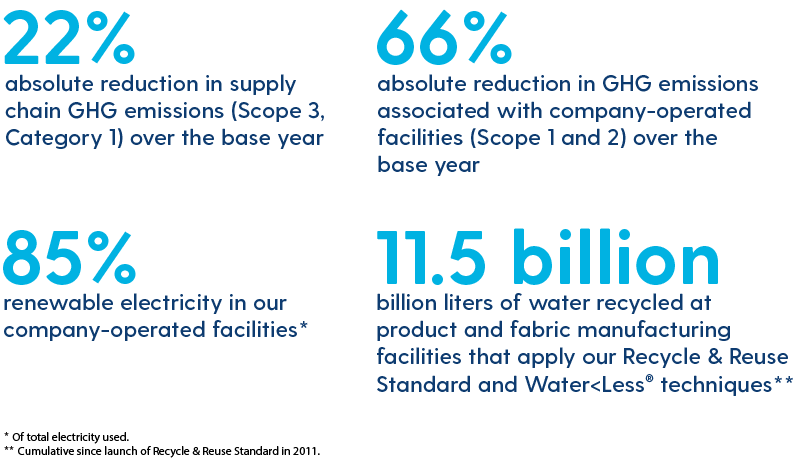Relevant frameworks in this pillar: GRI, SASB, TCFD, UNGC
Contributing to these UN SDGs: 6, 9, 12, 13, 15
Climate change poses significant threats to commerce and communities around the globe and is the existential challenge of our time. We all share a responsibility to act. Reducing our climate footprint across our value chain and galvanizing others for collective action are top priorities. While we acknowledge the challenges ahead and the many variables involved, we aim to leverage our innovation, supplier engagement, sustainable sourcing, advocacy and giving, while taking steps to strengthen our own business resilience to the effects of climate change. We’re committed to doing our part and expect that others are, too, since it will take concerted and collective action to address climate change. This includes reducing energy use and emissions as well as innovating to reduce freshwater use in our own operations and our supply chain — while striving to protect and restore biodiversity. Our supply chain, which includes the manufacturing of our products, is the biggest part of our footprint.
Water and climate issues are inextricably connected in what is often called the water-climate nexus, so we manage their risks and opportunities in tandem. The impacts of climate change can manifest as water-related events like droughts and floods. At the same time, water is used to keep traditional power plants cool and for some forms of renewable energy. Conversely, energy is used to pump water from aquifers for consumption, as well as for water treatment and distribution.
This intersection presents opportunities for us to address some water and climate impacts simultaneously. For instance, many of our Water<Less® techniques also reduce energy use by decreasing the energy needed to pump water into factories. In 2021, we completed a greenhouse gas (GHG) and cost modelling assessment across our supply chain. The process considered the water-climate nexus as we assessed both supplier water usage and possible interventions that would have a direct impact on GHG emissions. These range from simply adjusting temperatures to water pump installations and system upgrades.
Climate Goals
40% absolute reduction in supply chain GHG emissions*
By 2025
40% absolute reduction in supply chain GHG emissions*
By 2025
90% absolute reduction in GHG emissions and 100% renewable electricity in all company operated facilities**
By 2025
90% absolute reduction in GHG emissions and 100% renewable electricity in all company operated facilities**
By 2025
Net-zero emissions of greenhouse gases***
By no later than 2050
Net-zero emissions of greenhouse gases***
By no later than 2050
Reduce freshwater use in manufacturing by 50% in areas of high water stress****
By 2025
Reduce freshwater use in manufacturing by 50% in areas of high water stress****
By 2025
Continue to assess and identify material impacts and dependencies on nature across the value chain, in order to implement a comprehensive biodiversity action strategy
By 2025
Continue to assess and identify material impacts and dependencies on nature across the value chain, in order to implement a comprehensive biodiversity action strategy
By 2025
*Against 2016 base year. Supply chain GHG emissions refer to Scope 3, Category 1 (Purchased Goods and Services). While this goal was approved by SBTi under the apparel and footwear sector science-based targets guidance v.4.0, it will be adjusted to a 1.5°C trajectory as now required by the SBTi Net-Zero target application process.
**Against 2016 base year. This goal is consistent with limiting temperature rise to 1.5°C compared to pre-industrial levels.
***We plan to submit this goal for SBTi approval in 2023.
****Against 2018 base year.
Climate Highlights

Forward-Looking Statements
This Sustainability Report and related website contain forward-looking statements, including statements related to our sustainability strategies, initiatives and targets. We based these forward-looking statements on our current assumptions, expectations and projections. These forward-looking statements are estimates and involve a number of risks and uncertainties that could cause actual results to differ materially. These risks and uncertainties are detailed in our filings with the U.S. Securities and Exchange Commission, including our Forms 10-K and 10-Q. Other unknown or unpredictable factors also could have material effects on our future results, performance or achievements. All information in this Sustainability Report and related website was current only as of the date originally presented and we disclaim any obligation to update this information.
More About Climate










